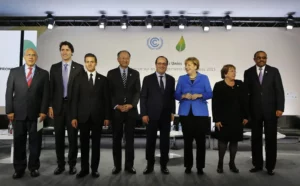GS 3 – ENVIRONMENT

Background
- Adopted at the 21st Conference of the Parties (COP21) to the UNFCCC in December 2015, held in Paris, France.
- Came into force on 4 November 2016.
- India ratified it on 2 October 2016 (Gandhi Jayanti).
Objective
- Limit global average temperature rise to well below 2°C above pre-industrial levels.
- Pursue efforts to limit it to 1.5°C to reduce climate risks.
- Achieve net-zero emissions in the second half of the 21st century.
Key Features
- Nationally Determined Contributions (NDCs)
- Countries voluntarily set their own targets for reducing greenhouse gas (GHG) emissions.
- Must update and enhance every 5 years.
- India’s updated NDCs (2022):
- Reduce emissions intensity of GDP by 45% by 2030 (from 2005 level).
- 50% of energy from non-fossil fuel sources by 2030.
- Create an additional carbon sink of 2.5–3 billion tonnes of CO₂-equivalent through forest cover.
- Global Stocktake
- Every 5 years, starting from 2023, to assess collective progress toward climate goals.
- Climate Finance
- Developed countries to mobilize $100 billion/year from 2020 to assist developing nations (extended till 2025).
- Finance to support mitigation and adaptation efforts.
- Technology Transfer and Capacity Building
- Developed countries to support clean technology sharing and capacity building in developing countries.
- Loss and Damage
- Recognition of loss and damage due to climate-related events (e.g., sea-level rise, extreme weather), though not legally binding on developed nations for compensation.
Legal Nature
- Not legally binding on emission reductions.
- Legally binding on procedural aspects like submission of NDCs and reporting.
India and Paris Agreement
- India’s climate actions are guided by the Panchamrit goals announced at COP26 (Glasgow, 2021):
- Non-fossil energy capacity: 500 GW by 2030
- 50% energy from renewables by 2030
- Reduce carbon intensity by 45%
- Reduce total emissions by 1 billion tonnes
- Net-zero by 2070




